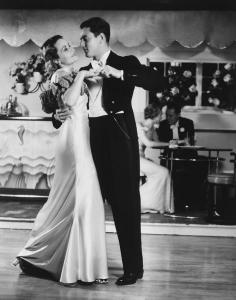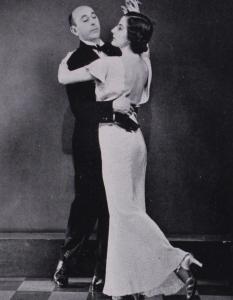- Historical Dance
- Jazz Age Social Dancing ("The Modern Dances")
- 0. The Essentials of Jazz Age Ballroom Dancing
- 1. Foxtrot Part 1: The Jazz Age Foxtrot
- 2. Youth Dancing in the Jazz Age
- 3. The Jazz Age Waltz
- 4. The Jazz Age Tango
- 5. 1930s Rumba
- 6. 1930s Samba
- 7. 1930s Conga
- 8. Bal Musette: Parisian Dance of the Jazz Age
- 9. Dancing in Weimar Berlin
- Dancing Made Easy - 1922
- Film Library - Jazz Age Dance
- Historical Dance Films posted to Pinterest
- Jazz Age Dance - Apologia
- Jazz Age Dance Image Collection
- Jazz Age Lead and Follow
- Places to Dance in Southern California in the Jazz Age
- Sampler of Jazz Age Dance Holds
- The Pathé Historical Dance Collection: 1920s-40s
- Ragtime Dance - the One Step
- Regency Dance
- Victorian Dance
- Jazz Age Social Dancing ("The Modern Dances")
3. The Jazz Age Waltz
In the 20s and 30s, the Waltz was evolving. The "old school" rotating Victorian Waltz was still in evidence in the English speaking world, but was being edged out by the "Modern Waltz" with a less directional and kinetic style with partners swaying back-and-forth or moving in a linear manner rather than pivoting around a circle.
In this period, waltzers used the very close Jazz Age embrace and as with most of the other ballroom styles of the time, the partners seldom left their close embrace. The underarm turns and the like, which are popular today were practiced primarily by professional exhibition dancers and not social dancers. With the partners in the embrace, steps were small and the dance was fairly contained and restrained, and generally did not display the sense of swooping and broad motion that modern competition ballroom Waltz now has or the high-speed, rapid rotation of the Viennese Waltz.
The Modern Waltz was elegant, romantic and quite intimate and like most of the ballroom dances of the era, was a conversation between partners, with little concern for putting on a show for any external audience.
Waltz Timing
The Waltz is in 3/4 time. There are three beats to every measure, and in a waltz, the first beat of every three has a clear accent. A waltz phrase is two sets of three, and could be expressed as ONE-two-three-FOUR-five-six. It's best to start your figure on the first beat of the 6 beat phrase. The key steps are on the strong downbeat at the beginning of each 3 beat measure.
 The Advancing Step
The Advancing Step
This basic step preserves the ONE-two-three timing of the step, but is danced Foxtrot fashion with the lead mostly backing the follow. The man steps forward with his left, shading slightly to the left, brings his right foot on line with his left and then brings his left next to his right (Left-Right-Together). He then does the mirror of that, still going forward, but shading a little to his right (Right-Left-Together). The lady, of course, does the opposite while backing. He may occasionally reverse and back up along line of direction, but mostly he backs her. However, if you take this step, and mix it up with the man stepping backward on the second 3-count phrase, then you have the Box Step.
The Box Step
The predominant step of the time was the "box-step", though done in a very loose, free-flowing style, with an almost random assortment of turns, reverses, shading and backing, all done with a pattern that is, for the lead, essentially thus:
(TAKE SMALL STEPS!)
1 Forward with the left
2 Forward with the right
3 Bring the left next to the right
4 Back with the right
5 Back with the left
6 Bring the right up next to the left
However, if you do this in the current style as an actual box, with equal sides, long steps and 90 degree angles, you're missing the point. Don't think "box" think "back and forth sway". With each step, turn a bit, side step a bit, cross-step a bit - rove all over the floor (but more or less in line-of-direction) and don't worry too much about exactly where your feet end up, so long as you keep on the beat and off your partner's toes and don't bump into your fellow dancers. And of course, in the free flowing dance of the Jazz Age, you can at any moment revert for a while to an old-fashioned pivot Waltz, and then switch back just as quickly to a more modern step - because it's the Jazz Age, and that's just how it is.
The essential thing to remember is that the Waltz step is not defined by direction, it is defined by rhythm. Certain feet always move on certain beats, but they might step forward, to the side, backward, across or perhaps just mark time in place.
Of all the many ways to Waltz, this back-and-forth box step is the best option for a crowded floor, as so many floors were in the Jazz Age.
Rotation
Rotation was a major element in Waltzing, though not to the extent it had been in the 19th Century or it was with the Viennese style.
The "Natural" turn is the most comfortable and, well, natural. If you take a long step forward with your left on the first beat of the first measure (ONE-two-three) and then step back with your right on the first beat of the second measure (FOUR-five-six), but rather than step straight back, move your right foot diagonally behind your left foot - then you will rotate clockwise in a "Natural" turn. You can do this slowly and easily, which is greatly recommended for beginners, or if you and your partner are comfortable and confident, you can speed it up and actually cover some ground and have a sense of continuous rotation.
As it speeds up it can become essentially the partners doing a sequence of: 1-2-3 the Leader, with a long first step passes in front of his partner while his partner pivots in place - followed on 4-5-6 by the Follower taking the long left foot stride while the Leader pivots. The pivot can be an actual pivot with the dancer simply rotating in place, but is more often a series of small steps, marking time in place while turning.
The "Reverse" turn is a little less intuitive, and may take some more practice. The key to this turn is the left foot. Instead of stepping forward on the first beat, it steps back, behind the right. Then the right moves forward slightly, carefully avoiding stepping on the partner's toes. Reverse turns are a nice variation if you can manage them smoothly, but not essential.
On a personal note: using the old dancers' trick of "spotting" (focusing on a distant point so your head is stable while your body turns - and then popping around to focus on another distant point) I can avoid dizziness through an infinite number of natural turns. However, I get dizzy very quickly when doing reverse turns. That's probably just me, but there it is.
 But if all that ONE-two-three stuff is just not working for you, in the Jazz Age there is no dance to which you can't just walk.
But if all that ONE-two-three stuff is just not working for you, in the Jazz Age there is no dance to which you can't just walk.
The Walking ("Canter") Waltz
(Also "Lame Duck Waltz")
"The Canter Waltz has been revived and presents an opportunity to show the use of "direction" in the straight backward and forward series of walking steps.
This dance is walking to waltz time but walking most quietly and gracefully. There are two steps to the three counts of music. Step forward on x and make the second step between the 2 and 3 count. Give the first step the accent, although the steps are almost of the same value.
It may, perhaps, help the student practicing alone with the aid of the victrola to count 1-&, 2-&, 3-&, making the second step on the second &, until able to do the step smoothly."
(Dancing Made Easy, Coll, 1922)
In teaching this step, I tell people to step on the strong first beat of the Waltz phrase, then, without changing weight bring their trailing foot up on beat 2-3 and do a slight rise, then on the next down beat, step out with the trailing foot and repeat. It really is just Step-on-the-downbeat, with the other foot wasting time until its turn to step.
1 Step Left
2-3 Slide Right up behind Left with a slight rise
4 Step Right
5-6 Slide Left up behind Right with a slight rise
This step is generally danced in a linear fashion, backing the lady and then perhaps, out of a sense of fairness, pivoting so that the man is backing. It could also be danced in a lazy box-step or you could throw in some of your favorite Foxtrot variations to liven it up a bit.
Even if you are an experienced dancer, and master of the most demanding forms of Waltz, I highly recommend you add the walking Waltz to your tool-box in case you find yourself dancing with someone who has never learned to Waltz. You can teach this step to anyone with a rudimentary sense of rhythm in about thirty seconds, which means that rather than three and a half awkward minutes of stress and frustration, you will enjoy a congenial though simple dance, and put off intensive instruction to a more appropriate time.
The step-on-the-downbeat style isn't just for those who can't quite master the regular Waltz step. It is also deuced handy when trying to dance to an ultra-fast Musette Waltz such as the Parisians tend to favor.
(For French Waltz of the Jazz Age, click here)
- Next: The Tango
I could try to describe the Jazz Age Waltz in greater detail but fortunately I don't have to. Here is a pastiche of 1920s and '30s Waltz footage: instructional films, ballroom competitors, movies and a newsreel of a London nightclub.
More

